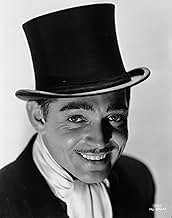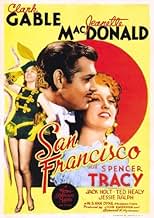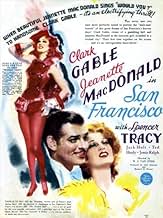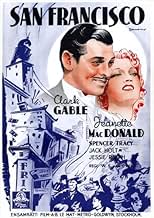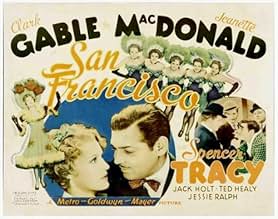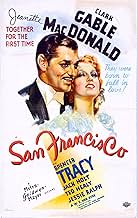IMDb RATING
7.1/10
6.4K
YOUR RATING
A Barbary Coast saloonkeeper and a Nob Hill impresario are rivals for the affections of a beautiful singer, both personally and professionally, in 1906 San Francisco.A Barbary Coast saloonkeeper and a Nob Hill impresario are rivals for the affections of a beautiful singer, both personally and professionally, in 1906 San Francisco.A Barbary Coast saloonkeeper and a Nob Hill impresario are rivals for the affections of a beautiful singer, both personally and professionally, in 1906 San Francisco.
- Director
- Writers
- Stars
- Won 1 Oscar
- 5 wins & 6 nominations total
Charles Judels
- Tony
- (as Charles Judells)
Warren Hymer
- Hazeltine
- (as Warren B. Hymer)
- Director
- Writers
- All cast & crew
- Production, box office & more at IMDbPro
Featured reviews
SAN FRANCISCO is a major Hollywood production from the 1930's, From the Boldness of the opening credits, along with a rousing rendition of the tune by the same name, the viewer suspects that they are going to witness a special movie event.
The plot is a rather forthright formula story of a tug-of-war romance between bad boy Clark Gable (Blackie Nortion, saloon owner) and mama's boy Jack Holt (Jack Burley, scion of a well-to -do family) for the affections of singer Jeanette MacDonald (Mary Blake, beautiful, virginal). It's also a story of good vs. evil, the good portrayed by Spencer Tracy as a Catholic Priest.
But it's the hard-hitting script and it's crisp dialogue, the recreation of a turn-of-the-Century San Francisco, the great acting, the music, and the fabulous Earthquake sequences that make this show the classic that it is.
SAN FRANCISCO is a tale of contrasts. On one hand the Barbary Coast with it's bars and bordellos, yet on the other hand we have a city of the fine arts, opera, and the Nob Hill elite. We have the rich, the spendthrifts, and also the poor who seek shelter in the Mission Houses.
The acting of Clark Gable cannot go unmentioned. His Blackie Norton is the most mockingly amoral character, proud of his lack of religious faith..... relying only on himself. Yet as Father Mullin (Tracy) says at one point in the movie, "Do you know who gave the chapel that organ we've been dedicating tonight? The most scoffing, unbelieving, and godless soul in all San Francisco, ..Blackie Norton. Cost him over $4,000......Don't tell him I told you. Blackie's like that, ashamed of his good deeds as most men are ashamed of their bad."
The famous 1906 Earthquake is a real show-stopper. Entire sets were hoisted on hydraulic lifts and rockers, and literally shaken down. VERY REALISTIC. I would have reservations about showing this picture to kids under 10 years of age. They may develop a neurotic fear of earthquakes following this one.
Enjoy and re-enjoy.
The plot is a rather forthright formula story of a tug-of-war romance between bad boy Clark Gable (Blackie Nortion, saloon owner) and mama's boy Jack Holt (Jack Burley, scion of a well-to -do family) for the affections of singer Jeanette MacDonald (Mary Blake, beautiful, virginal). It's also a story of good vs. evil, the good portrayed by Spencer Tracy as a Catholic Priest.
But it's the hard-hitting script and it's crisp dialogue, the recreation of a turn-of-the-Century San Francisco, the great acting, the music, and the fabulous Earthquake sequences that make this show the classic that it is.
SAN FRANCISCO is a tale of contrasts. On one hand the Barbary Coast with it's bars and bordellos, yet on the other hand we have a city of the fine arts, opera, and the Nob Hill elite. We have the rich, the spendthrifts, and also the poor who seek shelter in the Mission Houses.
The acting of Clark Gable cannot go unmentioned. His Blackie Norton is the most mockingly amoral character, proud of his lack of religious faith..... relying only on himself. Yet as Father Mullin (Tracy) says at one point in the movie, "Do you know who gave the chapel that organ we've been dedicating tonight? The most scoffing, unbelieving, and godless soul in all San Francisco, ..Blackie Norton. Cost him over $4,000......Don't tell him I told you. Blackie's like that, ashamed of his good deeds as most men are ashamed of their bad."
The famous 1906 Earthquake is a real show-stopper. Entire sets were hoisted on hydraulic lifts and rockers, and literally shaken down. VERY REALISTIC. I would have reservations about showing this picture to kids under 10 years of age. They may develop a neurotic fear of earthquakes following this one.
Enjoy and re-enjoy.
I have just watched the colorized version of this knock-out film. Whether in color or B &W, it is a powerfully entertaining film. When Blackie Norton finds religion and Mary Blake spots him, humbled and on his redemption encrusted knees,tears well up in my jaded eyes. Everything works so wonderfully in this film. Still, as destructive and tragic as the earthquake scenes are,this movie is basically a love story and what male would not swoon over the voice and the innocence of Mary Blake. Certainly not me.
San Francisco, like so many other films from this era, just reminds me again how movies today have lost the art of the build-up. They just hit you over the head with mind-numbing action from frame one. Hollywood(and audiences of today) would do well to watch classics like "San Francisco", where story takes precedence over special effects and when the effects do come, they are in service to the story. And they mean so much more and have so much more impact when held back until the last possible moment. Why can't we allow ourselves to be immersed in the story? Or are we just too impatient for it now?
"San Francisco" is a very good classic picture. It's in many ways kind of similar to "In Old Chicago", which came out a year after this film. Both films have love stories, both have beautiful sets, and both climax with a disaster that really did take place in their respective cities. "San Francisco" takes place in the mid-1900s. Clark Gable and Spencer Tracy are two of the thousands of people living in the city that was tragically rocked by the massive earthquake of 1906. Like "In Old Chicago", the disaster recreation here is impressive. The film tends to drag a little from time-to-time, but that's only a minor quarrel to an otherwise classy movie. All-in-all, I was pretty entertained by "San Francisco".
*** (out of four)
*** (out of four)
You can't go wrong with the pairing of two of the great stars of Hollywood, Gable and Tracy......and the great star of the west coast, San Francisco. The role of Blackie Norton may be one of Gable's best, so cynical,so devil-may-care and just a little bit dangerous. Tracy play the understanding priest with his usual aplomb. As he told someone once "Don't ever let them catch you acting".
Gable's attraction to Jeanette McDonald is a little bit unbelievable. She really did belong with Jack Holt in this film......or better yet Nelson Eddy should have showed up at the last minute and swept her away with a song. Gable and McDonald don't mesh at all and there was not much chemistry between them although I must admit she is lovely. Be that as it may, the film is one of the best of Hollywood's mid-30's offerings. There is something for everyone; music, drama, comedy and the finale of the earthquake which is what we are waiting for. And what a spectacle it is!! It is very well done in those days before sophisticated special effects; with tumbling buildings, crashing walls and the inevitable fire. There are a couple of poignant scenes when the firefighters must blow up buildings and homes to control the fire thus destroying lifetimes of work and memories.
The ending is a little bit over the top as those who have lost their families and all that they own, joyously sing the Battle Hymn of the Republic and march up the hill to view the destruction (I'm not sure I would be that upbeat)......but it is still effective. The fade to the modern day (1936) San Francisco is just the right ending note. I highly recommend this film, not only for the Gable/Tracy pairing but also for the general excellence of the production.
Gable's attraction to Jeanette McDonald is a little bit unbelievable. She really did belong with Jack Holt in this film......or better yet Nelson Eddy should have showed up at the last minute and swept her away with a song. Gable and McDonald don't mesh at all and there was not much chemistry between them although I must admit she is lovely. Be that as it may, the film is one of the best of Hollywood's mid-30's offerings. There is something for everyone; music, drama, comedy and the finale of the earthquake which is what we are waiting for. And what a spectacle it is!! It is very well done in those days before sophisticated special effects; with tumbling buildings, crashing walls and the inevitable fire. There are a couple of poignant scenes when the firefighters must blow up buildings and homes to control the fire thus destroying lifetimes of work and memories.
The ending is a little bit over the top as those who have lost their families and all that they own, joyously sing the Battle Hymn of the Republic and march up the hill to view the destruction (I'm not sure I would be that upbeat)......but it is still effective. The fade to the modern day (1936) San Francisco is just the right ending note. I highly recommend this film, not only for the Gable/Tracy pairing but also for the general excellence of the production.
Did you know
- TriviaClark Gable did not want to make this film but he was at the mercy of MGM studio head Louis B. Mayer, who had just paid off one of his numerous paramours.
- GoofsAs Blackie walks away from a building being blown up (actually a process shot), Clark Gable's head becomes momentarily transparent.
- Quotes
Jack Burley: [referring to Mary Blake] Well, there's no law against an opera singer being slender, young and beautiful.
- Crazy creditsPrologue: "San Francisco--guardian of the Golden Gate--stands today a Queen among seaports--industrious, mature, respectable. But perhaps she dreams of the Queen and city she was--splendid and sensuous, vulgar, and magnificent--that perished suddenly with a cry still heard in the hearts of those who knew her, at exactly 5:15 a.m. April 18, 1906."
- Alternate versionsAfter initial premiere, the manager of the Paramount Theater in San Francisco added to the downbeat ending a few shots showing the Golden Gate Bridge being built. Seeing the positive public reaction, MGM decided to have the sequence added to all other prints in release.
- ConnectionsEdited into What Price Safety! (1938)
- SoundtracksSan Francisco
(1936)
Music by Bronislau Kaper and Walter Jurmann
Lyrics by Gus Kahn
Played during the opening credits and often in the score
Sung by Jeanette MacDonald (uncredited)
Reprised by her and others at a political rally and at the end
- How long is San Francisco?Powered by Alexa
Details
- Release date
- Country of origin
- Language
- Also known as
- Grad greha
- Filming locations
- San Francisco, California, USA(background footage)
- Production company
- See more company credits at IMDbPro
Box office
- Budget
- $1,300,000 (estimated)
- Runtime1 hour 55 minutes
- Color
- Aspect ratio
- 1.37 : 1
Contribute to this page
Suggest an edit or add missing content



